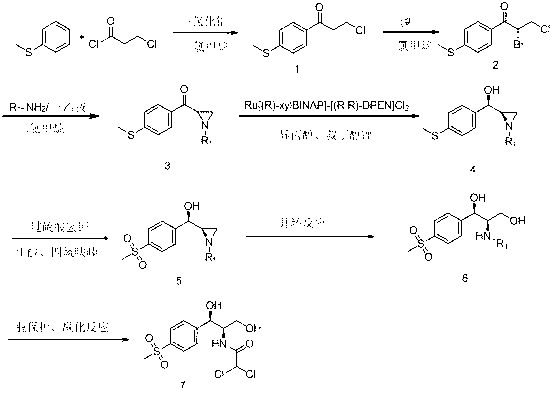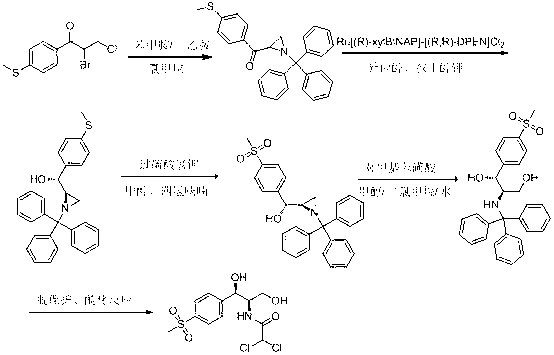Chiral catalytic synthesis method of thiamphenicol
A technology of thiamphenicol and a synthesis method, which is applied in chemical instruments and methods, preparation of organic compounds, organic chemistry, etc., can solve the problems of high waste water treatment cost, time-consuming, long route, etc., and achieves cost reduction and environmental impact. pollution, avoid splitting process, avoid the effect of waste water pollution
- Summary
- Abstract
- Description
- Claims
- Application Information
AI Technical Summary
Problems solved by technology
Method used
Image
Examples
Embodiment 1
[0031] Synthesis of 3-chloro-1-(4-(methylthio)phenyl)-1-propanone: Add aluminum trichloride (35.7 g, 268 mmol) and 200 ml of dichloromethane ( Anhydrous calcium chloride pre-dried), the system was connected to a drying tube, stirred, poured 3-chloropropionyl chloride (37.2 g, 293 mmol) into the reaction bottle, cooled to 0 ℃ in an ice bath, and added dropwise sulfide anisole (27.7 g, 223 mmol), after 2 hours dropwise (control the liquid temperature between -5-10°C), after the dropwise addition, move the reaction bottle into an oil bath and raise the temperature to 25°C to react for 1-3 hours. Pour the reaction solution into a 1000 ml beaker, add 100 ml of water while stirring in an ice bath, separate the liquids, extract with dichloromethane, combine the organic phases, wash once with saturated sodium bicarbonate, wash twice with water, dry over anhydrous sodium sulfate, and filter Sodium sulfate was removed, and the filter cake was washed with dichloromethane. After removing ...
Embodiment 2
[0034] Synthesis of compound 2-bromo-3-chloro-1-(4-(methylthio)phenyl)-1-propanone: add 3-chloro-1-(4-(methylthio) to a 500 ml three-necked flask at room temperature ) phenyl)-1-propanone (16.0 g, 74.5 mmol), dichloromethane 100 ml (anhydrous calcium chloride pre-dried), stirred. Add 4.0 ml of bromine (12.5 g, 78 mmol) and 100 ml of dichloromethane (pre-dried with anhydrous calcium chloride) into a 250 ml beaker, stir and mix evenly, pour into a constant pressure dropping funnel, and place on the reaction bottle . Cool the reaction flask in an ice-water bath. When the liquid temperature drops to 0°C, start adding bromine dichloromethane solution dropwise. After the addition was complete, the reaction was carried out for 1 hour. Add saturated sodium bicarbonate solution under ice bath until the aqueous phase is alkaline, separate the liquids, add saturated thiosulfate sodium solution to the organic phase under stirring until the organic phase is a colorless and transparent so...
Embodiment 3
[0036] Synthetic compound 1-benzyl-2-(4-(methylthio)phenyl)formyl aziridine: add 2-bromo-3-chloro-1-(4-methylthiophenyl )-1-propanone (5.0 g, 17 mmol), dichloromethane 100 ml, stirred and dissolved, and benzylamine (1.8 g, 17 mmol), triethylamine (3.6 g, 36 mmol) and dichloromethane were added dropwise at room temperature 50 ml of the mixed solution was reacted at room temperature for 3 hours, quenched by adding water, the organic phase was washed three times with water, dried over anhydrous sodium sulfate, and the organic solvent was removed to obtain 4.7 g of a light yellow solid with an HPLC detection content of 95.5%.
PUM
 Login to View More
Login to View More Abstract
Description
Claims
Application Information
 Login to View More
Login to View More - R&D
- Intellectual Property
- Life Sciences
- Materials
- Tech Scout
- Unparalleled Data Quality
- Higher Quality Content
- 60% Fewer Hallucinations
Browse by: Latest US Patents, China's latest patents, Technical Efficacy Thesaurus, Application Domain, Technology Topic, Popular Technical Reports.
© 2025 PatSnap. All rights reserved.Legal|Privacy policy|Modern Slavery Act Transparency Statement|Sitemap|About US| Contact US: help@patsnap.com



